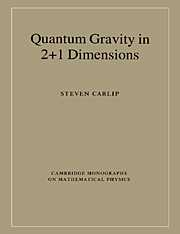Book contents
- Frontmatter
- Contents
- Preface
- 1 Why (2+1)-dimensional gravity?
- 2 Classical general relativity in 2+1 dimensions
- 3 A field guide to the (2+1)-dimensional spacetimes
- 4 Geometric structures and Chern–Simons theory
- 5 Canonical quantization in reduced phase space
- 6 The connection representation
- 7 Operator algebras and loops
- 8 The Wheeler–DeWitt equation
- 9 Lorentzian path integrals
- 10 Euclidean path integrals and quantum cosmology
- 11 Lattice methods
- 12 The (2+1)-dimensional black hole
- 13 Next steps
- Appendix A The topology of manifolds
- Appendix B Lorentzian metrics and causal structure
- Appendix C Differential geometry and fiber bundles
- References
- Index
3 - A field guide to the (2+1)-dimensional spacetimes
Published online by Cambridge University Press: 15 December 2009
- Frontmatter
- Contents
- Preface
- 1 Why (2+1)-dimensional gravity?
- 2 Classical general relativity in 2+1 dimensions
- 3 A field guide to the (2+1)-dimensional spacetimes
- 4 Geometric structures and Chern–Simons theory
- 5 Canonical quantization in reduced phase space
- 6 The connection representation
- 7 Operator algebras and loops
- 8 The Wheeler–DeWitt equation
- 9 Lorentzian path integrals
- 10 Euclidean path integrals and quantum cosmology
- 11 Lattice methods
- 12 The (2+1)-dimensional black hole
- 13 Next steps
- Appendix A The topology of manifolds
- Appendix B Lorentzian metrics and causal structure
- Appendix C Differential geometry and fiber bundles
- References
- Index
Summary
In the last chapter, we investigated two formulations of the vacuum Einstein field equation in 2+1 dimensions. In this chapter, we will solve these field equations in several fairly simple settings, finding spacetimes that represent a collection of point particles, a rotating black hole, and a variety of closed universes with topologies of the form [0, 1] ×∑. In contrast to (3+1)-dimensional general relativity, where it is almost always necessary to impose strong symmetry requirements in order to find solutions, we shall see that for simple enough topologies, it is actually possible to find the general solution of the (2+1)-dimensional field equations.
The reader should be warned that this chapter is not a comprehensive survey of solutions of the (2+1)-dimensional field equations. In particular, I will spend a limited amount of time on the widely studied point particle solutions, and I will say little about solutions with extended (‘string’) sources and solutions in the presence of a nonvanishing matter stress–energy tensor. The latter are of particular interest for quantum theory – they offer models for studying the interaction of quantum gravity and quantum field theory – but systematic investigation of such solutions has only begun recently, and they are not yet very well understood.
Point sources
As a warm-up exercise, let us use the ADM formalism of chapter 2 to find the general stationary, axisymmetric solutions of the vacuum field equations with vanishing cosmological constant. Such spacetimes are the (2+1)-dimensional analogs of the exterior Schwarzschild and Kerr metrics, representing the region outside a circularly symmetric gravitating source.
- Type
- Chapter
- Information
- Quantum Gravity in 2+1 Dimensions , pp. 38 - 59Publisher: Cambridge University PressPrint publication year: 1998

